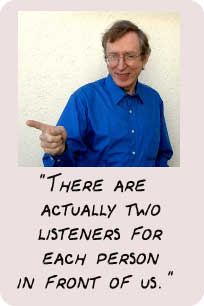|
|
Katalina Groh, Larry Prusak: Some of the world's leading thinkers |
| Storytelling to ignite change: Steve Denning |
 |
The
little voice in the head
In fact, there are two listeners
in the room that we need to be thinking about When I look at someone,
I see the physical person in front of me, but there is also, as Ben Zander
points out, the little voice in the head. And we all know what the little
voice in the head is. And if you’re asking yourself, “What is he talking
about? What on earth does he mean by ‘the little voice in the head’?”,
well, that’s exactly the little voice that I mean!
|
| And the conventional view
of communications is: let’s just ignore the little voice in the head. Let’s
just hope that it doesn’t get in the way and let’s hope that everything
goes o.k. Unfortunately, that often doesn’t happen. The little voice
gets busy, and before you know it, the listener is getting a whole new
and often unwelcome perspective on what the speaker is talking about.
What I am suggesting to you is something different. What I am saying is: exploit the little voice in the head. Take advantage of it. Make use of it. And the way that you do that is that you tell a story in a certain way that elicits a second story. The little voice in the head tells a second story. In effect, what I am doing is: I am giving the little voice in the head something to do. And so when I say, “Let me tell you about something that happened in Pakistan, I am hoping that the little voice in the head is saying, “We’re working in health. Why couldn’t we do this?” Or if you are working in finance, “Why don’t we do this in finance?” Or if you are working in Africa, “Why don’t we try this in Africa?” In effect, the little voice starts to imagine a new story, a new set of actions for the listener, another kind of future. And if things are going well, the little voice in the head starts to flesh out the picture. It starts to say: “Of course, we would have to have a community. We would need to get organized. We would need budgets to make it happen. And we would have to get more people involved. But why don’t we do it? Why don’t we get on with making this happen?” And when this happens, the little voice is already racing ahead to figure out how to implement knowledge sharing in the organization. And because the listener has created the idea, it regards the ideas as his or her own baby. And of course, you love your own baby. You created the idea. It’s yours! |
| Books and videos on storytelling *** In Good Company : How Social Capital Makes Organizations Work by Don Cohen, Laurence Prusak (February 2001) Harvard Business School Press *** The Social Life of Information, by John Seely Brown, Paul Duguid (February 2000) Harvard Business School Press *** The Springboard : How Storytelling Ignites Action in Knowledge-Era Organizations by Stephen Denning (October 2000) Butterworth-Heinemann *** The Art of Possibility, a video with Ben and Ros Zander : Groh Publications (February 2001) |
| The views expressed on this website are those of Stephen Denning, and not necessarily those of any person or organization |
| Site optimized in 800x600: webmaster CR WEB CONSULTING |
|
|
|
|